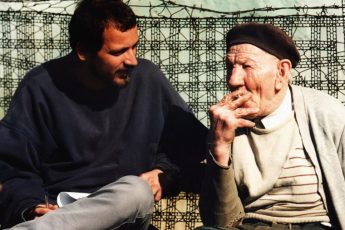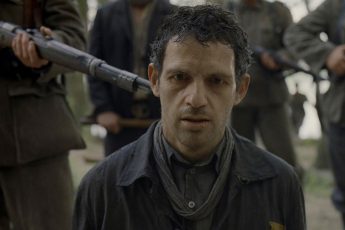The God of the Hungarians
Zoltán Fábri’s Professor Hannibal (Hannibál tanár úr, 1956)
Vol. 30 (June 2013) by Konstanty Kuzma
Mass protests by university students, dubious suspensions, a fire caused by misconduct, a corrupted, opportunistic academic council and an alignment of research with ideology: Zoltán Fábri’s image of the education system in Professor Hannibal would be end-to-end sordid if it weren’t for Béla Nyúl, a beacon of sanity in Fábri’s scrupulous world. With thin hair, a sinuous posture and a soft voice, the conscientious teacher is grey and inconspicuous, noticed only after a paper of his is published by the academic council. The publication, which reassesses the death of Carthaginian general Hannibal, attracts wide public attention. Suddenly, the stiff man is showered with gifts and felicitations by neighbors, colleagues and friends, gladly embracing the achievement with well-earned champagne and cigars. But the euphoria – crowned with a dream in which Nyúl meets Hannibal face-to-face – lasts but one night, as the local paper launches a diatribe against Nyúl for his “revolutionary” essay: there, Nyúl claims that Hannibal didn’t die of poisoning, as widely believed, but fell victim to an uprising in Carthage, an idea not quite in line with the agenda of the ruling right-wing government. The atmosphere tips, and Nyúl finds himself to be an enemy of the state, hated and persecuted for a text unaffiliated to political ambition.
The film, released in 1956, the same year that the failed Hungarian Revolution took place (where over 2 000 civilians lost their lives at the hands of Soviet and Hungarian authorities), could be interpreted as a depiction of the growing dissatisfaction of Hungarians with the Communist regime. The centralized education system, a one-party reality, and the involuntary, public self-renunciation of Nyúl point to the realities of pre-’45 Hungary as much as they work in their Communist pendant: though there are some explicitly nationalist rhetoric in the film, it is the common denominators of political extremism that are most prominent. Still, other, suspiciously uncritical films of Fábri (most notably Twenty Hours, from 1965) raise doubts about his intentions to draw parallels to the Soviet regime. At any rate, today, with another anti-democratic shift in Hungary’s history, another reference point to Fábri’s film has appeared: the Hungary of Viktor Orban, conceived in 2010 when his center-right party Fidesz won the parliamentary elections with a landslide victory. Since then, the charismatic prime minister has been instrumentalizing democratic tools to deconstruct democracy, ever more confidently defying foreign and domestic criticism. His government, populist at heart, both shares the nationalism of the “Töhötöm” movement from Professor Hannibal, and the consolidating drive of the 1956 regime, reminding us that 1989 was not that long ago yet, and that democracy (unlike Fidesz?) is not yet cemented in Hungary.
Systematic comparisons (Nazi Germany vs. Soviet Union, Slavery in North America vs. Slavery in Russia, Pragmatism vs. Logical Positivism etc.), though helpful in bringing out both parallels and differences, have inflated the academic world to the point that they have become a discipline of their own. This is good because comparisons allow for greater academic contextualization, and bad because this filing is often the only thing they contribute to research on the subjects concerned. In the case of political realities, however, they are crucial for understanding what direction a political system is heading. In Hungary in particular, rhetoric are no reliable indication of a government’s intentions. The ruling camps since 1989 (from both sides of the political spectrum) have outbid each other with corruption and untrustworthiness. Orban, a leading figure in bringing down the Communist regime in Hungary, declared in 1989 that democracy and Communism don’t go together, a statement that could be updated: almost 25 years later, his government seems just as reluctant to take a democratic path as his rivals were.
In Fábri’s film, hopes for democratic change are low (looking back at history, that’s a realistic prognosis indeed). The people’s admiration for Nyúl’s work fades as quickly as it appears, with all forces accepting the authorities’ designation of the innocuous professor as a traitor. Only children, a young colleague and the inn keeper’s promiscuous wife appear to respect him independently of political happenings – hardly a lobby in the face of totalitarian authorities and a ragtag society of servile hypocrites. Like Pintilie in The Reenactment, Fábri opts for a symbolic ending to convey his political message. Nyúl attends the rally of the governing “Töhötöm” movement, where Lord Muray, its local representative, holds a speech in which he fulminates the professor passionately. Muray had promised Nyúl support, but ends up being a leading force in defaming him. Calmly “reminding” him that he has children, he invites him to give a statement for his accusations. In classical Stalinist fashion, the public dialogue is a charade: Nyúl has no choice but to recant his views on Hannibal and express support for Muray’s nationalist propaganda, which is concluded by the shady leader’s declaration that the “God of the Hungarians still lives”. Facing sentencing, Nyúl ends up propagating a message he himself rejects, very much unlike the Barber from Chaplin’s Great Dictator (1940), who is able to foist humanistic values onto an equally hostile crowd (which, unfortunately, does appear to be the less realistic rendition of the situation).
Nyúl’s reiteration of “Töhötöm”’s message is also strikingly close to Viktor Orban’s specious rhetorics which itself appear to appeal to the “Trianon Syndrome,” Hungarians’ struggle to come to terms with losing 71 percent of their territory after WWI. Historically multiethnic, Hungarians became largely homogeneous after 1918, a development which paved the way for extremist sentiments. Today, as pre-‘45 nationalism is experiencing a renaissance, atheists, Jews, foreigners and revolutionists – the enemies of the “Töhötöm“ movement-, are suppressed or vilified alongside the Roma by Orban & Co., yet more severely by Jobbik, Hungary’s far-right party. Racial segregation in schools, contested media laws, a weakening of the constitutional court: the list of troubling amendments and laws that have passed since Orban became prime minister in 2010 is long. With a two-third majority in the parliament, Fidesz is giving the constitution a noticeable makeover. But like Lord Muray, Orban is a political chameleon, skillfully downplaying anti-democratic tendencies. His appearances before the EU parliament in Brussel, where he underlines his commitment to democracy while signalling complaisance, belie his imminent nationalism and his attempts to consolidate power.
A former dissident, one recognizes Orban in his Communist enemies. With courts and media outlets losing independence and the film fund now largely centralized, the country is steadily tiptoeing back in time. The interchangeability of Hungary’s nationalist and Communist past in Professor Hannibal thus also transfers to the present. Indeed, Fidesz fits neatly into the extremists’ club: Orban, too, justifies totalitarian measures by embedding them into larger narratives, for instance Hungarians’ historic struggle to resist outer forces (this is also the main argument which the PM uses to discredit criticism from the EU). That many Hungarian intellectuals demand resistance under Fidesz won’t unsettle him: like the Communists in Professor Hannibal, Orban is unlikely to recognize himself in his enemies. Parliamentary elections in Hungary are due next year, and while economic stagnation and the gradual decline of civil liberties have alienated some voters, the God of the Hungarians will be watching.




Ha ha… you think 2013 Orban is bad? Wait till 2015 Orban appears.
It’s 2022 now, Jobbik moved to center-right, Fidesz is far-right, and still rules with constituent majority.